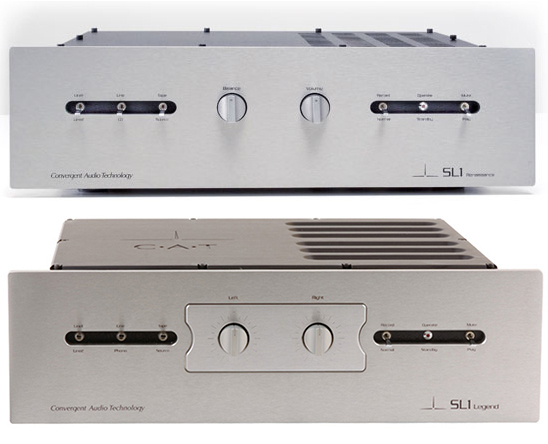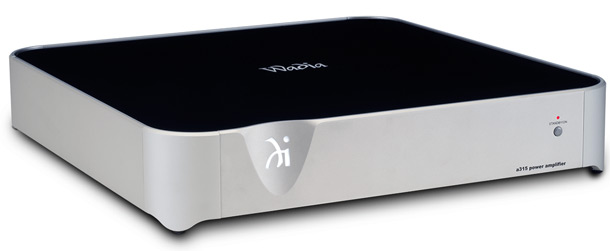
Wadia a315, a340, di122

Da Wadia segnaliamo un gruppo tre elettroniche: due amplificatori finali di potenza di cui l’a315 stereo e l’a340 mono, più un DAC – che l’azienda preferisce chiamare Digital Audio Decoder – di122.
Il finale stereo Wadia a315 fornisce 150 watt per canale su 8 ohm, o 250 watt per canale a 4 ohm. Il finale mono Wadia a340 eroga 400 watt a 8 ohm, o 500 watt a 4 ohm. Entrambi condividono lo stesso elegante e moderno design, adatto ad essere inserito in qualsiasi ambiente.
Il finale stereo a315 presenta alcune delle più recenti tecnologie di Wadia, come la Frequency Switching Transmission™ (FST) , un progetto di modulazione adattativa nel circuito amplificatore, che assicura piena potenza di uscita su tutto lo spettro audio. La Signal Surveyor™, che controlla il segnale di uscita e si blocca l’amplificazione se vengono rilevati livelli pericolosi di tensione continua, proteggendo così gli altoparlanti.
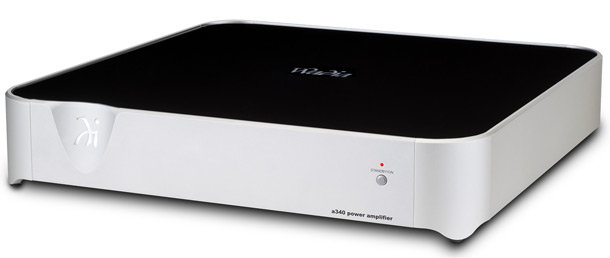
Il finale mono Wadia a340 adotta le stesse tecnologie dell’a315 con in più la IO Symmetry™, un circuito di bilanciamento globale del segnale, dall’ingresso fino allo stadio di uscita, per un totale accoppiamento differenziale del sistema, con una conseguente riduzione del rumore e aumento della qualità audio.
Entrambi gli amplificatori sono forniti di ingressi bilanciati e sbilanciati, mentre il finale a340 offre anche uscite bilanciate e sbilanciate per facilitare i collegamenti di configurazioni bi-amp.
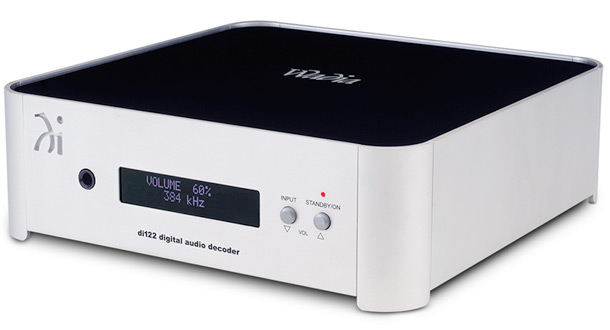
Il Digital Audio Decoder (DAC) Wadia di122 a due canali è dotato di due ingressi coassiali e due ottici, che accettano segnali fino a 24 bit / 192 kHz. Un ingresso USB che accetta segnali fino a 32 bit e supporta il DSD64, DSD128, DXD 352.8 kHz e DXD 384 kHz.
Questi numerosi ingressi e formati supportati consentono di disporre di una grande varietà di sorgenti digitali. Inoltre, il DAC Wadia di122 dispone anche di un’uscita cuffie ad alta potenza.

Caratteristiche tecniche amplificatore Wadia a315
- POWER OUTPUT: 150 watts into 8 ohm loads; 250 watts into 4 ohm loads
- OUTPUT LOAD IMPEDANCE: 8 ohms or 4 ohms
- RATED POWER BAND: 20Hz to 20 kHz
- TOTAL HARMONIC DISTORTION: 0.1% maximum harmonic distortion at any level from 250 milliwatts to one-half of rated power output, 20 Hz to 20 kHz; 0.5% maximum harmonic distortion at any level from one-half to full rated power output, 20 Hz to 20 kHz
- DYNAMIC HEADROOM: 1 dB 8 ohm load; 1.6 dB 4 ohm load
- FREQUENCY RESPONSE: +0, –0.5d B from 20 Hz to 20 kHz; +0, –3.0 dB from 10 Hz to 70 kHz
- INPUT SENSITIVITY: 2.4 V Balanced; 1.2 V Unbalanced
- A-WEIGHTED SIGNAL TO NOISE RATIO: 90 dB (112 dB below rated output) Balanced; 88dB (110dB below rated output) Unbalanced
- INTERMODULATION DISTORTION: 0.1% maximum if instantaneous peak power output does not exceed the rated output for any combination of frequencies from 20 Hz to 20 kHz
- WIDE BAND DAMPING FACTOR: Greater than 320, 8 ohm load; Greater than 160, 4 ohm load
- INPUT IMPEDANCE: 10 Kohms Balanced and Unbalanced
- VOLTAGE GAIN: 29 dB
- TRIGGER INPUT: 5-15 V DC, <1 mA
- TRIGGER OUTPUT: 12 V DC, 50 mA maximum, delayed 0.2 seconds
- OVERALL DIMENSIONS: W 45.4 x Height 8.6 (including feet) x D 50.8 cm (including cables)
- WEIGHT: 12.2 kg

Caratteristiche tecniche amplificatore Wadia a340
- POWER OUTPUT: 400 watts into 8 ohm loads; 500 watts into 4 ohm loads
- OUTPUT LOAD IMPEDANCE: 8 ohms or 4 ohms
- RATED POWER BAND: 20 Hz to 20 kHz
- TOTAL HARMONIC DISTORTION: 0.1% maximum harmonic distortion at any level from 250 milliwatts to one-half of rated power output, 20 Hz to 20 kHz; 0.5% maximum harmonic distortion at any level from one-half to full rated power output, 20 Hz to 20 kHz
- DYNAMIC HEADROOM: 1.7 dB 8 ohm load; 2.7 dB 4 ohm load
- FREQUENCY RESPONSE: +0, –0.5 dB from 20 Hz to 20 kHz; +0, –3.0 dB from 10 Hz to 70 kHz
- INPUT SENSITIVITY: 4 V Balanced; 2 V Unbalanced
- A-WEIGHTED SIGNAL TO NOISE RATIO: 90 dB (116 dB below rated output) Balanced; 87 dB (113 dB below rated output) Unbalanced
- INTERMODULATION DISTORTION: 0.1% maximum if instantaneous peak power output does not exceed the rated output for any combination of frequencies from 20 Hz to 20 kHz
- WIDE BAND DAMPING FACTOR: Greater than 320, 8 ohm load; Greater than 160, 4 ohm load
- INPUT IMPEDANCE: 10 Kohms Balanced and Unbalanced
- VOLTAGE GAIN: 29 dB
- TRIGGER INPUT: 5-15 V DC, <1 mA
- TRIGGER OUTPUT: 12 V DC, 50 mA maximum, delayed 0.2 seconds
- OVERALL DIMENSIONS: W 45.4 x H 8.6 (including feet) x D 50.8 cm (including cables)
- WEIGHT: 12 kg
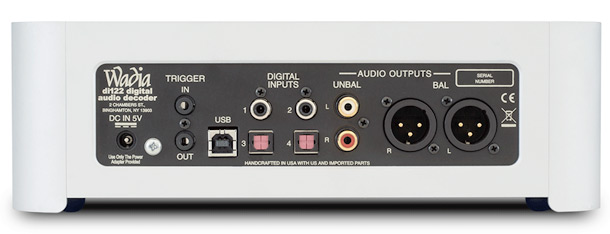
Caratteristiche tecniche DAC Wadia di122
- Frequency Response: ±0.5 dB from 20 Hz to 20,000 HzTotal Harmonic Distortion: 0.005%
- Variable Output Level: 0 – 4.0 V rms Unbalanced; 0- 8.0 V rms Balanced
- Signal To Noise Ratio (A-Weighted): 105 dB
- Dynamic Range: 98 dB
- Output Impedance: Less than 100 ohms (Unbalanced and Balanced)
- Digital Input Signal Format: Coaxial and Optical Inputs – SPDIF (PCM); USB Input – PCM, DSD
- Digital Input Sample Rate: Coaxial and Optical: 44.1 kHz to 192 kHz, 24-Bit
- USB: 44.1 kHz to 384 kHz, 32-Bit (PCM), DSD64, DSD128, DXD352.8 kHz, DXD384 kHz
- Digital Inputs: Coaxial 1 and 2 0.5V p-p/75 ohms; Optical 1 and 2 –15 dbm to –21 dbm (TOS Link); USB Type B Connector
- Trigger Input: 5-15 V DC, less than 1 mA
- Trigger Output: 12 V DC, 25 mA maximum total
- Power Requirements: 100-240 Volts, 50/60 Hz at 10 Watts (Only use the AC/DC Power Adapter supplied with the Wadia di122)
- Standby: Less than 0.5 watt
- Overall Dimensions: Width 25.4 x H 8 (including feet) x D 35.6 cm (including cables)
- Weight: 3.2 kg
Produttore: WADIA


























